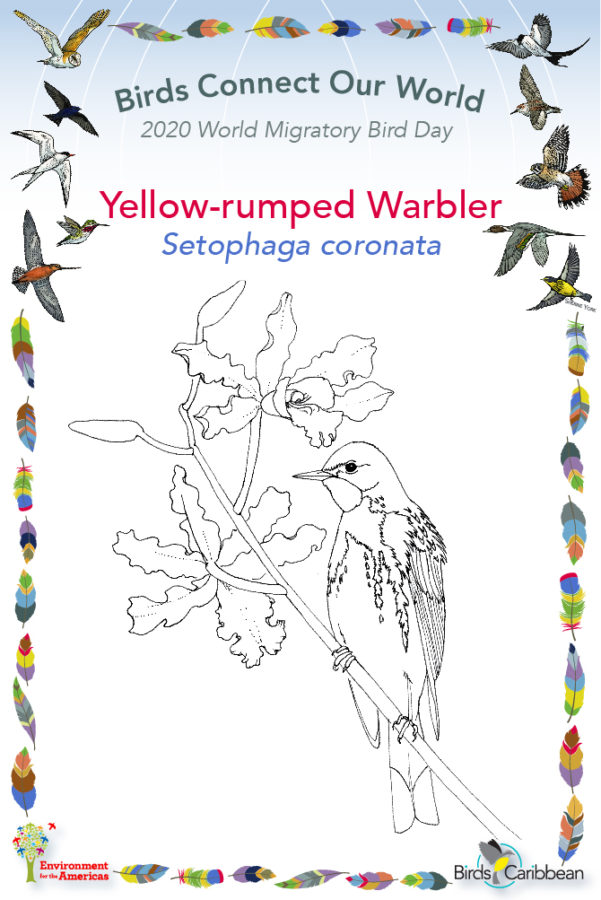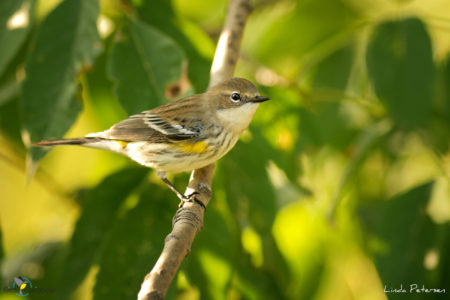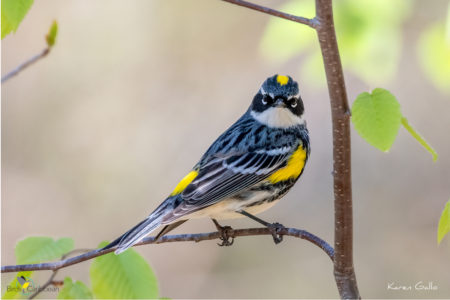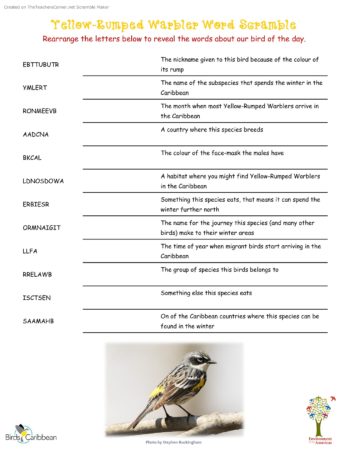Celebrate World Migratory Bird Day (WMBD) with us in our virtual “Birds Connect Our World” edition! Have fun learning about a new migratory bird every day. We have colouring pages, puzzles, activities, and more. Download for free and enjoy nature with your family at home.

Migratory Bird of the Day: Yellow-rumped Warbler

There is no mystery as to where the Yellow-rumped Warbler got its name, you are likely to see a flash of its trademark yellow rump patch as it flits around in a tree. In fact its nick-name is “butter-butt”! This bird also has bright yellow patches on the sides of its breast and a distinctive white throat. Breeding Males are vividly coloured and have a black mask across their eye. They also have black and white streaking on the chest. Females and younger birds look similar but are duller and brownish on the back and head. Males will look also look brownish during the winter. All birds at all times of year still have the distinctive white-ish throat and yellow rump.
There are two subspecies of this warbler, known as “Audubon’s” and “Myrtle.” It is the “Myrtle” subspecies which is most likely to be in the Caribbean (and which is described above). The “Audubon’s” subspecies has a yellow throat and no black eye-mask.
Yellow-rumped Warblers are one of the most common and wide-spread warblers. They breed across a wide area of Canada and the Northern US and in the autumn migrate south to the southern US, Central America, and the Caribbean. They are one of the last migrants to arrive, typically not turning up until November. They spend the winter here, and are most commonly found in the Bahamas and islands of the Greater Antilles.
Unlike many of the migratory warblers Yellow-rumped Warblers like to hang out together and are often seen in small groups. In the Caribbean, they live in woodlands, gardens, scrubby areas, coffee plantations, mangroves, and the edges of swamps. They eat insects and can sometimes be spotted making looping flights from perches to snatch insects out of the air. Unlike many warblers they also eat berries of many different plants. The fact that they can digest the wax berry coating means that Yellow-rumped Warblers can survive colder temperatures when there are no insects by eating bayberries and wax myrtle berries. Learn more about this species, including its range, photos, and calls here.
Colour in the Yellow-rumped Warbler!
Download the page from Migratory Birds of the West Indies Colouring Book. Use the photos below as your guide, or you can look up pictures of the bird online or in a bird field guide if you have one. Share your coloured-in page with us by posting it online and tagging us @BirdsCaribbean #WMBD2020Carib
Listen to the call of the Yellow-rumped Warbler
The call of the Yellow-rumped Warbler is an abrupt “check”
Puzzle of the Day
Click on the images below to do the puzzles. You can make the puzzle as easy or as hard as you like – for example, 6, 8, or 12 pieces for young children, all the way up to 1,024 pieces for those that are up for a challenge!


Activity of the Day
FOR KIDS: Read the text above to find out facts about the Yellow-rumped Warbler. Then use the clues to rearrange the letters and reveal the words in our Yellow-rumped Warbler word scramble! Find the answers here.
FOR KIDS AND ADULTS:
- Take a walk and see if you can spot a migratory warbler or any of our other migratory birds. Use a bird field guide or the FREE Merlin bird ID app to help you identify the birds you are seeing.
- Enjoy the videos below of both male and female Yellow-rumped Warblers. The female in the first video is eating myrtle berries. In the second video you can see a male in breeding plumage.
- Visit MigratoryBirdDay.org for many more free activities and resources to learn about migratory birds, their threats and conservation actions you can take.

